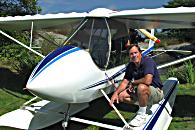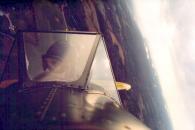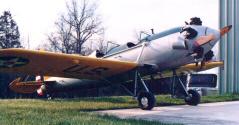|
Recently, fellow Challenger owner and friend, Bryan Quickmire wrote a feature story for Aviation Quarterly on the experiences of his first summer of float flying in the Challenger. In it, he spoke of "The Waving Phenomenon". I know exactly what heís referring to. The Challenger seems to be very intriguing to people when they see it fly past and a fool proof conversation starter when itís on the ground (or water or snow). I guess it has something to do with the fascination of flight and the planeís friendly low speed that makes it look so appealing and carefree. Whatever it is, it has a magic effect on people. They immediately stop whatever theyíre doing to watch and wave as you fly by, frantically pointing and calling any friends who have not yet looked up. Often people who are further away from the flight path will whip off a scarf, jacket or in summer a beach towel and wave it like mad to lure you over for a closer look. If you oblige and then salute them with a wave or wing waggle, they are clearly thrilled. I frequently skim the endless frozen runway of the Ottawa River on skis in the wintertime. The ice fishermen, cross country skiers, skaters, snowmobilers and the rest wave as I pass. Barbie Hill, an old and dear family friend occasionally comes flying with me on skis and one day she summed it up perfectly. ďI feel just like Queen Elizabeth riding in my carriage and waving to all my subjectsĒ. Exactly. If you land and stop, a spontaneous migration of people takes place, all converging on the plane full of curiosity and questions. I know of no other device which serves so effectively as a people magnet and conversation starter. Itís much the same on floats. In the water though, you have to be a little wary after you land because when the instant migration takes place, it frequently includes big, fast boats storming in for a closer look, only to pull their throttles back abruptly as they get close, and unintentionally greet you with a set of personalized tidal waves. Itís survivable on floats as they are watertight, so except for bouncing around like a cork in a storm, itís only an inconvenience. However Iím not sure Iíd want to be looking at these Tsunamis coming from the cockpit of a flying boat type airplane where the fuselage/hull sits low in the water. Swamping would certainly be a possibility. Lest I leave the impression that everybody always waves, I need to mention a couple of non wavers. Prominent among them were a couple enjoying the serenity at the top of a cliff on Rigaud Mountain near where I live. I was flying high above the fields, but tucked in tight to the top of the ridge following the contours of the mountain, also enjoying the serenity and view and alone with my thoughts. Imagine our mutual surprise when I rounded a corner to find this couple deep in the energetic throes of love making, suddenly discovering that they were not as alone as they had thought they were. This has happened to me more than once in the plane, but perhaps these are stories for another time.
This has resulted in my getting to fly (or fly in) some pretty interesting
hardware over the years. When I started flying Challengers 13 years ago, I had no idea that the airplane itself would open so many doors or introduce me to so many people, but it has been surprisingly effective in that role. Along with the many enthusiastic members of the International Challenger Owners Association, there has been no shortage of welcome mats out and friendships to be shared, not to mention all the friendly waving from countless total strangers. As Bryan so eloquently put it in his float article after first discovering The Waving Phenomenon: "I bet theyíre thinking: 'That looks like fun! Wish I could do it!' Donít they realize they can?"
To learn and see more order our comprehensive information package and video! |



